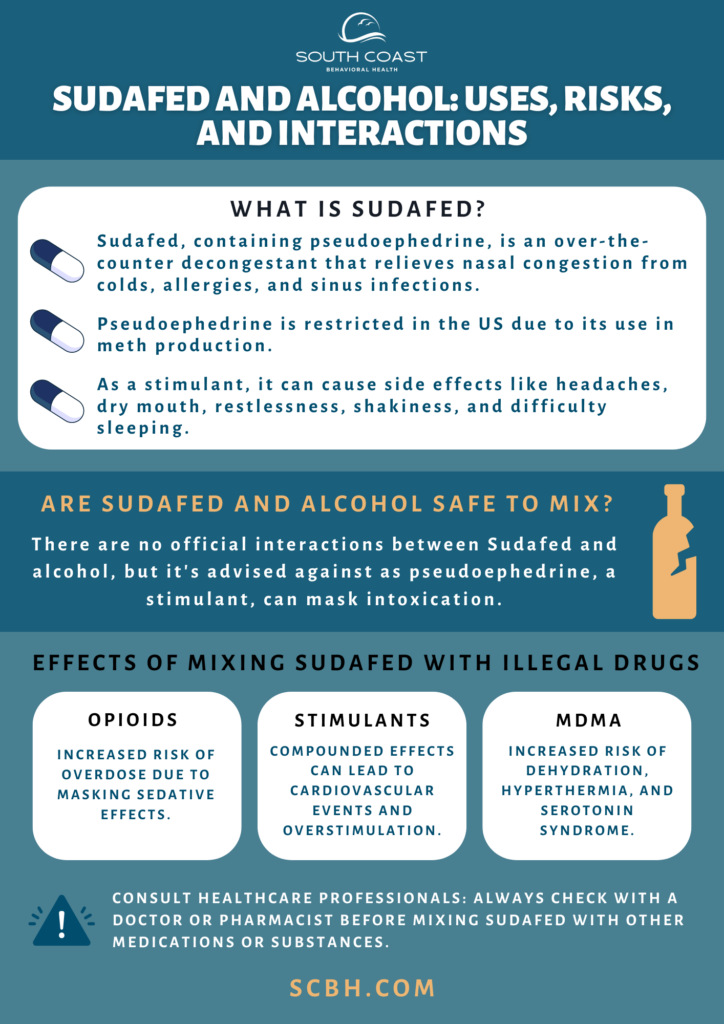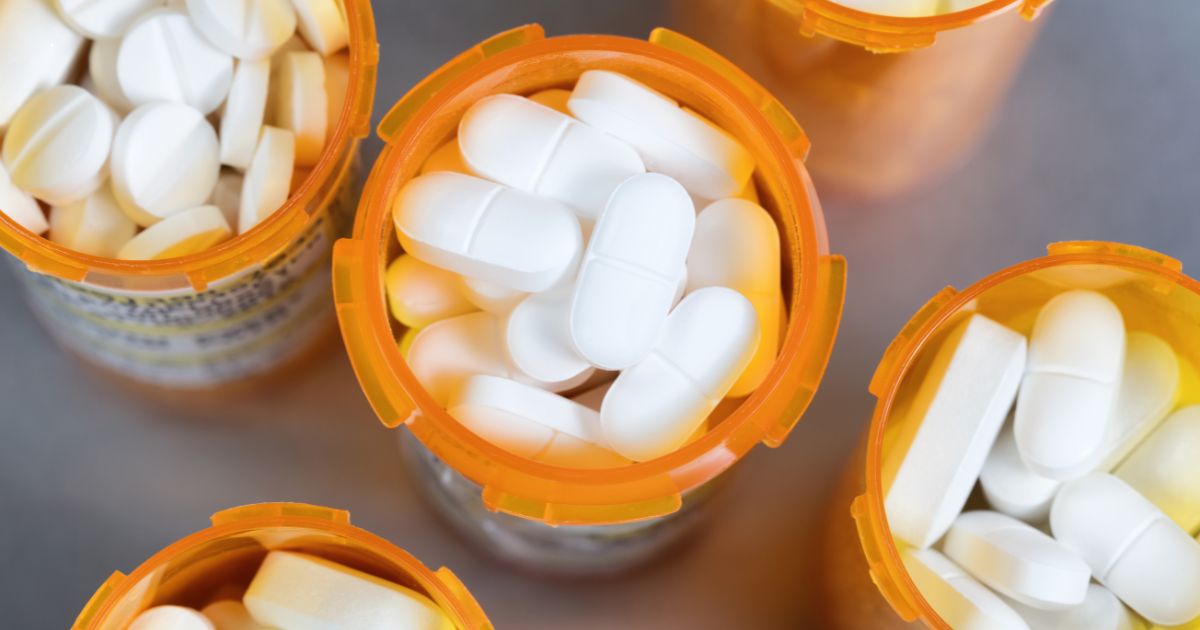If you’ve seen the show Breaking Bad, you’ll remember Sudafed figured prominently in some of the early episodes. That’s because it can be chemically changed to synthesize methamphetamine, also known as crystal meth. For that reason, it was taken off pharmacy shelves in 2006.
You may also know Sudafed can be used to treat symptoms of the common cold, such as nasal congestion. But beyond that, you may not be totally aware of every aspect of the drug – especially any interactions it may have with alcohol or other substances.
In this article, we’ll go a little more in-depth into what Sudafed is.
What is Sudafed?
Sudafed is a brand name for a medication whose primary active ingredient is pseudoephedrine. Pseudoephedrine, part of a class of drugs called alpha-adrenergic agonists, is an over-the-counter (OTC) decongestant. It’s used to relieve nasal congestion caused by colds, allergies, and sinus infections.
Because pseudoephedrine can be used as a precursor in the illegal production of methamphetamine, the purchase of medications containing pseudoephedrine is restricted in the US.
Being a stimulant, pseudoephedrine contains a number of side effects that can be expected from drugs of its class.
Common side effects to Sudafed include:
- Feeling or being sick
- Headaches
- A dry mouth
- Feeling restless, nervous, or shaky
- Difficulty sleeping
Less common side effects can include:
- Difficult or painful urination
- Dizziness or light-headedness
- Fast or pounding heartbeat
- Increased sweating
- Nausea or vomiting
- Trembling
- Unusual paleness
- Weakness
The following people should not take pseudoephedrine:
- Diabetics
- Those with cardiovascular disease
- People with uncontrolled hypertension or hyperthyroidism
- Pregnant women
- Women who are breastfeeding
- Children under the age of four
Sudafed is not regulated under the Controlled Substances Act. However, the Combat Methamphetamine Epidemic Act of 2005 created federal laws that limit an individual’s ability to buy such products to no more than three packages or nine grams per transaction. Boxes are typically kept behind the pharmacy counter, and buyers might be required to show identification and sign a logbook.
Get confidential help from our addiction treatment specialists in Orange County. Call to join our rehab program today!
Call 866-881-1184
Are Sudafed and Alcohol Safe to Mix?
There are no official interactions between Sudafed and alcohol. However, medical authorities still advise against it. Pseudoephedrine is a stimulant, and stimulants have been known to mask intoxication.
This can result in increased alcohol consumption, since you may not know how the alcohol is affecting you, leading to a hangover. Alcohol-related injuries, hangovers, and even alcohol poisoning could also occur.
It’s also worth noting here that alcohol is a depressant, and that mixing stimulants and depressants is generally a bad idea. In the case of alcohol and Sudafed, taking the two together could lead to worse hangovers, as Sudafed already causes hangover symptoms like headaches and dizziness. Sudafed and alcohol both disrupt sleep, meaning you could end up sleep-deprived, which would itself worsen any hangover from drinking.
Additionally, Sudafed and alcohol may work at cross-purposes when it comes to their effects on blood vessels. Sudafed constricts blood vessels whereas alcohol dilates them. This could lead to unpredictable changes in blood pressure, possibly negating the Sudafed, as well as increasing the risk of cardiac issues.
How Long After Taking Sudafed Can I Drink Alcohol?
In order to be safe, you should wait for the Sudafed to be completely cleared from your body before drinking alcohol. How long pseudoephedrine stays in your system depends on the dosage and formulation you buy.
According to the manufacturer of Sudafed, the drug has a half-life of 5 to 6 hours. So, once it’s been about 5 or 6 hours after your last dose of Sudafed, it’s safe to consume alcohol.
That said, there are stronger types of Sudafed (like 12-hour and 24-hour Sudafed), which require more time to clear from the body:
- SUDAFED® Sinus 12 Hour Pressure + Pain — When you take 12-hour Sudafed, it stays in your system for around 12 hours. Then, during the next 5 to 6 hours, it is completely eliminated from the body. Therefore, drinking alcohol about 20 hours after taking 12-hour Sudafed is probably safe.
- SUDAFED® Sinus Congestion 24 Hour —Because 24-hour Sudafed contains a larger dose than 12-hour Sudafed and other quick-release formulations, using it with alcohol is riskier. It’s best to wait 30 to 32 hours before consuming alcohol again.
It might be prudent to avoid alcohol altogether while you’re on the medication. If you do decide to consume alcohol after taking Sudafed, you should be particularly cautious and monitor for any enhanced side effects. If you are taking any kind of prescription medication, always consult with a certified healthcare professional before drinking.
Mixing Sudafed and Illegal Drugs
It’s never a good idea to take illegal drugs, especially if you’re mixing them with other substances.
In the case of pseudoephedrine, the possible interactions depend on the illegal drug with which it’s taken.
Here are some interactions and potential effects of mixing Sudafed (pseudoephedrine) with various types of drugs:
Sudafed and Opioids
Interaction: Combining opioids, which are central nervous system depressants (like morphine, heroin, oxycodone, and hydrocodone) with pseudoephedrine, a stimulant, can result in a masking effect. The stimulant properties of Sudafed may reduce the drowsiness caused by opioids, leading individuals to believe they can take more opioids than they normally would.
Risks: This combination can lead to overdose or respiratory depression because a person might consume a dangerously high amount of the opioid without feeling its full sedative effects until it’s too late.
Sudafed and Stimulants
Interaction: When two stimulants like cocaine or amphetamines are mixed, the effects can be synergistic, meaning they can compound or amplify each other. This can lead to dangerously increased heart rate, blood pressure, and overstimulation of the central nervous system.
Risks: Increased risk of cardiovascular events such as heart attack, arrhythmia (irregular heartbeat), and stroke. There’s also a higher likelihood of anxiety, paranoia, and hallucinations.
Note: Interestingly, according to one study, pseudoephedrine and methamphetamine don’t seem to interact, at least when the former is at typical dosages. When combined, the “rewarding” effects of PE and MA were either just added together (additive) or were even less than that (sub-additive). This means combining them did not make them more “rewarding” than either drug alone.
While the study notes it may reinforce the effects of methamphetamine at high doses, normal pharmaceutical doses of pseudoephedrine don’t seem to have any effect. The other key finding is that the delivery mechanism matters; pseudoephedrine seems to have little abuse potential in its typical oral form.
However, abusing methamphetamine is obviously still a terrible idea.
Sudafed and MDMA
Interaction: MDMA, also known as “ecstasy,” or “molly,” is both a stimulant and a serotonergic drug. Mixing it with pseudoephedrine can increase stimulant effects, putting strain on the heart and increasing other potential risks.
Risks: Elevated heart rate, high blood pressure, increased risk of dehydration, hyperthermia (overheating), and serotonin syndrome—a potentially life-threatening condition where too much serotonin accumulates in the brain, leading to symptoms like agitation, confusion, rapid heartbeat, and high fever.
Looking for quality substance abuse treatment that’s also affordable? South Coast accepts most major insurance providers. Get a free insurance benefits check now.
Check Your CoverageMixing Sudafed and Over-the-Counter Drugs
It’s important to use caution when mixing Sudafed with other medications, including over-the-counter (OTC) drugs, due to potential interactions.
Here are some significant interactions to be aware of:
Other Decongestants
You shouldn’t take Sudafed with other medications that contain pseudoephedrine, phenylephrine, or other decongestants. This could increase the risk of side effects, including increased blood pressure and heart rate.
Caffeine
Both Sudafed and caffeine can increase your heart rate. Be cautious if consuming large amounts of caffeine when using Sudafed.
MAO Inhibitors
These are a type of antidepressant. If you’re taking an MAO inhibitor, you should avoid Sudafed because the combination can lead to dangerously high blood pressure.
Tricyclic Antidepressants (TCAs)
TCAs are tricyclic antidepressants that can be used to treat depression and anxiety. Some can also be used to treat insomnia and to avoid migraines. Amitriptyline, imipramine, and nortriptyline (Pamelor) are a few examples.
TCAs increase the availability of specific substances in your brain. Norepinephrine is one of these molecules, and it can raise your heart rate and blood pressure. This interaction, when taken with pseudoephedrine, can result in elevated blood pressure and irregular pulse.
It’s best to avoid pseudoephedrine if you’re taking a TCA. Consult with your doctor or pharmacist about a safer alternative.
Phentermine
Phentermine (Adipex-P, Lomaira) is an appetite suppressant. It suppresses your hunger by acting on the brain. However, it can also create other stimulant effects such as increased blood pressure and rapid heartbeat.
Phentermine, like other appetite suppressants, can interact with pseudoephedrine. This combination may raise your blood pressure and heart rate. This combination should be avoided.
Linezolid
Linezolid is used to treat a wide range of bacterial illnesses. Skin infections, pneumonia, and other illnesses fall within this category.
Linezolid, although being an antibiotic, possesses characteristics comparable to MAOIs. As a result, it can interact similarly to pseudoephedrine and create extremely high blood pressure. If at all possible, avoid this combo.
Ergot Derivatives
Ergot derivatives are used to treat migraines, Type 2 diabetes, and Parkinson’s. Examples include dihydroergotamine (Migranal, Trudhesa), ergotamine (Ergomar), and bromocriptine (Parlodel, Cycloset).
Combining ergot derivatives and pseudoephedrine can result in a hazardous increase in blood pressure. It is better to avoid this combo.
Polysubstance Abuse Treatment
Polysubstance abuse refers to the misuse of more than one drug, either simultaneously or sequentially. The complexity of treating polysubstance abuse lies in addressing the combination of substances being used, as each can have its own unique set of effects, risks, and withdrawal symptoms. Effective treatment requires a comprehensive and holistic approach, treating both disorders simultaneously.
Treating Polysubstance Abuse at South Coast Behavioral Health
For those struggling with addiction, South Coast Behavioral Health offers compassionate and affordable addiction treatment.
The first step is going through a medical detox. Our medical detox program in California is staffed by caring and compassionate professionals who can provide you with medications to manage your withdrawal symptoms.
At South Coast, we take pride in offering care that is closely tailored to specific issues. To that end, we offer gender-specific detox programs, with medical detox for men in Irvine, CA, and medical detox for women in Huntington Beach, CA.
After detoxing, proper treatment can begin.
Treatment for substance abuse takes place along an entire spectrum of care. Along that entire spectrum are various behavioral therapies, support groups, and the use of medically-assisted treatment (MAT).
These levels of treatment are, in order, as follows:
Residential Treatment in California
After successfully completing medical detox, you’ll move to inpatient treatment in Orange County, California. There, you’ll receive medically-assisted treatment and dual diagnosis treatment to deal with any cravings or co-occurring mental health issues you may be battling. We also offer residential treatment facilities in Costa Mesa, Irvine, and Huntington Beach for those who desire gender-specific treatment. There, patients get round-the-clock medical attention and monitoring while living at the facility full-time.
In addition to individual and group counseling and medication management, you’ll also have access to leisure activities and family support services.
Partial Hospitalization in California
Most clients start substance abuse treatment with South Coast in our residential treatment program. After completing that, many desire something that still provides structure and support, but with extra space and time to oneself. For that, we offer Partial Hospitalization in Newport Beach.
A step down from inpatient care but with more structure than conventional outpatient programs, partial hospitalization offers a good balance for those looking to ease back into normal life. Clients can receive care five to seven days a week for a number of hours each day, returning back to their sober living homes in the evening.
This way, they can recover without putting their daily lives completely on hold, receiving intense therapeutic interventions like group and individual therapy, skills development, and medication management as necessary.
Intensive Outpatient Treatment in California
For those leaving inpatient residential treatment or partial hospitalization, intensive outpatient programs (IOP) are yet another gradual step forward on the road to recovery.
With a focus on group therapy, individual counseling, and education, clients undergoing Intensive Outpatient Treatment in Newport Beach can meet three to five days a week. Each session lasts three hours.
This level of care requires the least amount of attendance at a facility.
Get Started Today
If you or a loved one are struggling with substance addiction but wonder how long addiction counseling takes or have other questions, call us at 866-881-1184 or contact us here. Our highly qualified staff will be happy to help give you an idea on what to expect from your addiction recovery timeline, help verify your insurance, and assist with any other questions you may have.
- Side effects of pseudoephedrine – NHS (www.nhs.uk)
- Pseudoephedrine (Oral Route) Side Effects – Mayo Clinic
- Self-administration of (+)-methamphetamine and (+)-pseudoephedrine, alone and combined, by rhesus monkeys – PMC (nih.gov)
- The Controlled Substances Act (dea.gov)
- CMEA (The Combat Methamphetamine Epidemic Act of 2005) (usdoj.gov)
- The Top 7 Pseudoephedrine (Sudafed) Interactions to Know About – GoodRx









